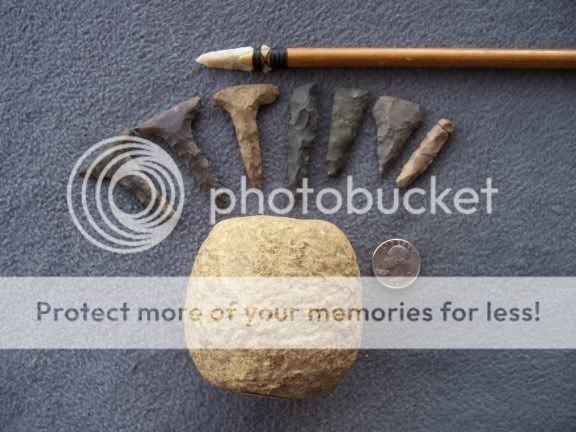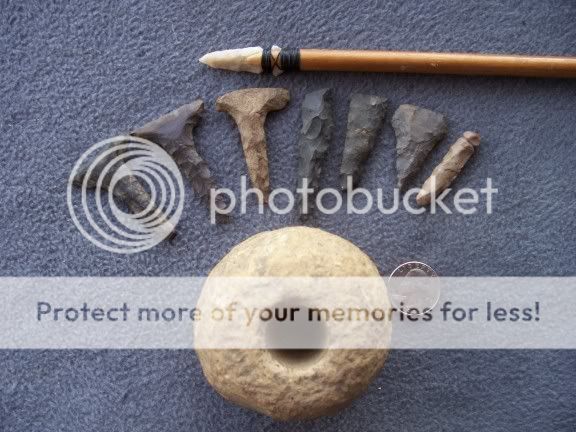It looks like you're using an Ad Blocker.
Please white-list or disable AboveTopSecret.com in your ad-blocking tool.
Thank you.
Some features of ATS will be disabled while you continue to use an ad-blocker.
share:
Coolio, But how did they drill the holes you may ask??? Well easy(when you know the trick), they made drills from flint and also the sand and cane
method(sand under the wooden drill shaft when spun abrade's the "mother" stone and makes the hole. The ones to the left are called "T Drills" for
their shape, then the Pencil drill's, a Reamer for enlarging the hole(pipe bowls by shape of this one), and a very worn out drill tip that has a
groove in it, maybe a Pendant worn by the craftsman who was the drilling king for his group??? The funky shaped stone (called a Cap Stone)is the "top
bearing" of a bow drill set up, used with the drill I made and hafted to an old cedar arrow, it gives weight straight down to point of drill and
helps speed-up the drilling process. You can see the "pecking" real good on this, apple shaped and fits the hand super well...With these drills it
is amazing how fast you can blow through stone, bone and, shell...




By holding and studying Indian relic's you can see how they were made and more importantly how they were used. The R&D has already been done by the
ancient's, and if a hide scrapper, Axe, or drill is needed the idea on how to make and use one is there today.... Any comments or questions??????
Originally posted by Oneshot1
and I find my-self thinking of another consuming passion/addiction of mine, hunting and collecting arrowheads and other Indian relics
Oneshot1,
Your post got me to recalling an indian tool I was shown in someones private collection. This individual too collected arrow heads and spear points. However his collection included something which to me was very unusual. It is the only one I have seen.
It was a stone which looked like a large tooth smooth and curved on one side with a indentation in the side of it. What he told me was that this was a stone used by the women for scraping the hair off hides. Over time the stone acquired a flat chisel tooth type edge ...slightly rounded from all the scraping... but it also had from all the exertions involvedd...a indentation from the thumb of the women holding it. When he told me about the indentation on the side of this stone I thought...wow!!!! How many women had to us this stone to wear a thumb indentation into the side of it. He also told me such a stone would be a valuable tool amont the women and inhereted/passed on from mother to daughter....through generations.
I enjoyed looking at all his arrow heads and spear points ..but this tool just stood out for its rarety.
This fisherman from a small fishing village in North Carolina also told me about the system of trails from north to south and east to west of this country and how the indians could get goods from one area of the country to another. His knowlege of these details was fascinating.
I remember this infomative and intresting private collection because of the unusual nature of this one artifact I am describing.
Thanks,
Orangetom
That was probably a treasured tool that was used everyday to get the great finger use wear marks on it. Alot of the hand tools would be made to fit
the hand and some are very well worn from just finger pressure and rubbing. The trade route's went from coast to coast and north to south, with
different area's having goods for trade...By the way.... about 10% of Indian tools can be classed as for a left-handed person, about the same amount
of left-handed folk's then as now...
new topics
-
How To Spot Fake U.F.O. Photos
Aliens and UFOs: 11 hours ago
top topics
-
LA Mayor Bass Demanded $49M in Additional LAFD Cuts One Week Before Wildfires
Mainstream News: 17 hours ago, 17 flags -
Just Came Across These Unusual Old UFO Pics
Aliens and UFOs: 15 hours ago, 7 flags -
Scary video of face in an abandoned house
Paranormal Studies: 13 hours ago, 5 flags -
How To Spot Fake U.F.O. Photos
Aliens and UFOs: 11 hours ago, 5 flags
